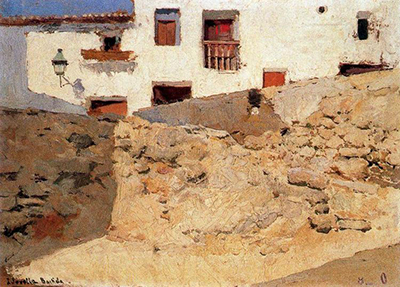 Buy Art Prints Now
Buy Art Prints Nowfrom Amazon
* As an Amazon Associate, and partner with Google Adsense and Ezoic, I earn from qualifying purchases.
Adobe Houses is a rare example of Joaquin Sorolla depicting the local architecture and brickwork of a Spanish village. He may have been influenced by the work of some fellow artists who had done similar earlier in their careers.
Sorolla was an artist who loved to capture life - normally through the eyes of young children running around and playing, or from the perspective of the working poor going about their daily tasks. He would sometimes diverge from this, though, possibly to refresh his creative juices or alternatively perhaps just to prove to himself that he could still handle other genres successfully. Within this piece we find several homes facing us from behind some rough brickwork which may have been adapted into a small path in order to navigate around this rural village. One can immediately get a sense of the bright sun beating down, with a dark shade contrasting on the right against the bright palette that Sorolla made use of in the latter part of his career. Each and every stone is faithfully reproduced within this painting and the slightly unusual composition by the standards of Sorolla means this may have been a sudden choice, rather than a well thought out piece.
The artist would produce study drawings for some of his more complex artworks and follow the standard routines of preparation as used for centuries, but in examples such as Adobe Houses, it appears to have come about purely by chance as he wandered around this pretty village. As someone who loved to use tones of white within many of his works, the facades of these simple buildings would have immediately pricked his interest. It may have been that this painting was actually a type of study in itself, as a means to develop Sorolla's understanding of depicting stone surfaces accurately. One can only really speculate on that point because there is not a huge amount of information available on this painting, not at least that has been translated into English as yet. It may therefore reside in a private collection, as most publically owned artworks from his career have been fairly comprehensively documented by now, particularly those in the Prado and Sorolla Museums in Madrid, Spain.
Sorolla would become one of the most famous Spanish artists in history and part of this success was from his wide ranging oeuvre which displayed a breadth of technical ability and imagination. His family portraits were delightful, but he also produced good amounts of social realism too, as well as working with darker palettes in the earlier part of his career as he was working under the influence of the old Spanish masters such as Goya and Velazquez. He would eventually settle on a much brighter palette which proved popular with the public and ensures that prints of his best work are still frequently in demand today, over a century after his passing. We then see further variety in the architectural studies found here, one of several that he made over a short period of time.



